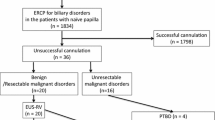Abstract
Purpose
To demonstrate the feasibility and safety of PTE-RV performed in a single session.
Materials and methods
This is a retrospective review of a prospective database on ERCP between January 2014 and December 2018. PTE-RV was performed in case of second ERCP failure. Technical success was defined as the establishment of an intestinal access to the biliary tract using a PTE-RV procedure allowing an immediate internal biliary drainage. Safety endpoints included intra-operative complications, morbidity and mortality occurring within 30 days after the procedure.
Results
Eighty-four patients (44 M/40F) with a median age of 69 years (range 40–91 years) underwent combined PTE-RV. The PTE-RVs were successfully performed in the same session in 80 subjects, resulting in an overall technical success rate of 95.2%. Adverse events were observed in 19% (16/84) of cases. The mortality rate within 30 days after the procedure was 9.5%.
Conclusion
Percutaneous transhepatic–endoscopic rendezvous technique is feasible in a single session with acceptable level of risk. A randomized trial is required to compare EUBD and PTE-RV.

Similar content being viewed by others
References
Coté GA, Singh S, Bucksot LG, Lazzell-Pannell L, Schmidt SE, Fogel E, McHenry L, Watkins J, Lehman G, Sherman S (2012) Association between volume of endoscopic retrograde cholangiopancreatography at an academic medical center and use of pancreatobiliary therapy. Clin Gastroenterol Hepatol Off Clin Pract J Am Gastroenterol Assoc 10:920–924. https://doi.org/10.1016/j.cgh.2012.02.019
Nennstiel S, Weber A, Frick G, Haller B, Meining A, Schmid RM, Neu B (2015) Drainage-related complications in percutaneous transhepatic biliary drainage: an analysis over 10 Years. J Clin Gastroenterol 49:764–770. https://doi.org/10.1097/MCG.0000000000000275
Sharaiha RZ, Khan MA, Kamal F, Tyberg A, Tombazzi CR, Ali B, Tombazzi C, Kahaleh M (2017) Efficacy and safety of EUS-guided biliary drainage in comparison with percutaneous biliary drainage when ERCP fails: a systematic review and meta-analysis. Gastrointest Endosc 85:904–914. https://doi.org/10.1016/j.gie.2016.12.023
Hedjoudje A, Sportes A, Grabar S, Zhang A, Koch S, Vuitton L, Prat F (2019) Outcomes of endoscopic ultrasound-guided biliary drainage: a systematic review and meta-analysis. United Eur Gastroenterol J 7:60–68. https://doi.org/10.1177/2050640618808147
Bokemeyer A, Müller F, Niesert H, Brückner M, Bettenworth D, Nowacki T, Beyna T, Ullerich H, Lenze F (2019) Percutaneous-transhepatic-endoscopic rendezvous procedures are effective and safe in patients with refractory bile duct obstruction. United Eur Gastroenterol J 7:397–404. https://doi.org/10.1177/2050640619825949
Neal CP, Thomasset SC, Bools D, Sutton CD, Garcea G, Mann CD, Rees Y, Newland C, Robinson RJ, Dennison AR, Berry DP (2010) Combined percutaneous-endoscopic stenting of malignant biliary obstruction: results from 106 consecutive procedures and identification of factors associated with adverse outcome. Surg Endosc 24:423–431. https://doi.org/10.1007/s00464-009-0586-0
Yang MJ, Kim JH, Hwang JC, Yoo BM, Kim SS, Lim SG, Won JH (2017) Usefulness of combined percutaneous-endoscopic rendezvous techniques after failed therapeutic endoscopic retrograde cholangiography in the era of endoscopic ultrasound guided rendezvous. Medicine (Baltimore) 96:e8991. https://doi.org/10.1097/MD.0000000000008991
Tomizawa Y, Di Giorgio J, Santos E, McCluskey KM, Gelrud A (2014) Combined interventional radiology followed by endoscopic therapy as a single procedure for patients with failed initial endoscopic biliary access. Dig Dis Sci 59:451–458. https://doi.org/10.1007/s10620-013-2913-5
Calvo MM, Bujanda L, Heras I, Cabriada JL, Bernal A, Orive V, Miguelez J (2001) The rendezvous technique for the treatment of choledocholithiasis. Gastrointest Endosc 54:511–513. https://doi.org/10.1067/mge.2001.118441
Wayman J, Mansfield JC, Matthewson K, Richardson DL, Griffin SM (2003) Combined percutaneous and endoscopic procedures for bile duct obstruction: simultaneous and delayed techniques compared. Hepatogastroenterology 50:915–918
Weber A, Gaa J, Rosca B, Born P, Neu B, Schmid RM, Prinz C (2009) Complications of percutaneous transhepatic biliary drainage in patients with dilated and nondilated intrahepatic bile ducts. Eur J Radiol 72:412–417. https://doi.org/10.1016/j.ejrad.2008.08.012
Chang JH, Lee IS, Chun HJ, Choi JY, Yoon SK, Kim DG, You YK, Choi M-G, Choi K-Y, Chung I-S (2010) Usefulness of the rendezvous technique for biliary stricture after adult right-lobe living-donor liver transplantation with duct-to-duct anastomosis. Gut Liver 4:68–75. https://doi.org/10.5009/gnl.2010.4.1.68
Dhondt E, Vanlangenhove P, Geboes K, Vandenabeele L, Van Cauwenberghe L, Defreyne L (2019) No evidence of improved efficacy of covered stents over uncovered stents in percutaneous palliation of malignant hilar biliary obstruction: results of a prospective randomized trial. Eur Radiol. https://doi.org/10.1007/s00330-019-06374-7
Isayama H, Komatsu Y, Tsujino T, Sasahira N, Hirano K, Toda N, Nakai Y, Yamamoto N, Tada M, Yoshida H, Shiratori Y, Kawabe T, Omata M (2004) A prospective randomised study of “covered” versus “uncovered” diamond stents for the management of distal malignant biliary obstruction. Gut 53:729–734. https://doi.org/10.1136/gut.2003.018945
Isayama H, Komatsu Y, Tsujino T, Yoshida H, Tada M, Shiratori Y, Kawabe T, Omata M (2002) Polyurethane-covered metal stent for management of distal malignant biliary obstruction. Gastrointest Endosc 55:366–370. https://doi.org/10.1067/mge.2002.121876
Hyun H, Choi SY, Kim KA, Ko SB (2016) Safety and efficacy of percutaneous biliary covered stent placement in patients with malignant biliary hilar obstruction; correlation with liver function. Cardiovasc Intervent Radiol 39:1298–1305. https://doi.org/10.1007/s00270-016-1375-5
Author information
Authors and Affiliations
Corresponding author
Ethics declarations
Disclosures
Drs Cyril Chivot, Clara Yzet, Roger Bouzerar, Franck Brazier, Sami Hakim, Jean Philippe Le Mouel, Eric Nguyen-Khac, Richard Delcenserie and Thierry Yzet have no conflicts of interest or financial ties to disclose.
Additional information
Publisher's Note
Springer Nature remains neutral with regard to jurisdictional claims in published maps and institutional affiliations.
Rights and permissions
About this article
Cite this article
Chivot, C., Yzet, C., Bouzerar, R. et al. Safety and efficacy of percutaneous transhepatic–endoscopic rendezvous procedure in a single session. Surg Endosc 35, 3534–3539 (2021). https://doi.org/10.1007/s00464-020-07812-0
Received:
Accepted:
Published:
Issue Date:
DOI: https://doi.org/10.1007/s00464-020-07812-0




